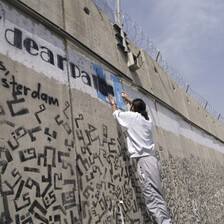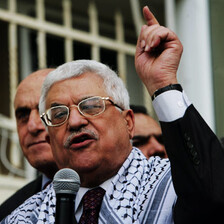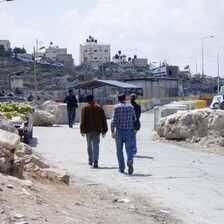“Total quiet.” This is what is expected from Palestinians. They want total quiet while they continue to make our lives miserable. After nine months of killings, great suffering, excessive force, liquidation, collective punishments, detentions and torture, destruction and demolition and on top of that shelling and bombings, Palestinians are expected to remain silent. After 53 years of dispossession, expulsion and discrimination, 34 years of military occupation, colonialism and another form of Apartheid, the international community, run by the United States, expects total quiet.
Just tell me how? Yesterday, I had an appointment in Sheikh Jarrah, a neighborhood in occupied East Jerusalem. When I walked outside the office I saw a huge line of cars waiting before the checkpoint before the office. As I walked behind the road and the little iron box which hosts three and sometimes more Israeli soldiers, I noticed that these cars were not blocked by the soldiers at this checkpoint but the line of cars continued upwards the road.
“Hey you!”
“Hey you!”, one of the Israeli soldiers shouted towards me. “What?”, I replied, while keeping walking to the other side. “Hey!”, he shouted again, pointing to me that I should come over. I stopped for a moment, thinking whether to continue or abide to the soldier, occupying this part of the land. I walked slowly towards the iron cabin.
The soldier of probably Ethiopian origin asked my identity card. “I don’t have one”, I said. He looked surprised. As I realised that he didn’t speak english, I gave him my Dutch passport. Disturbed he looked at the cover. I noticed that he didn’t had much experience and that he didn’t want to ask his superior for advice. As I got annoyed by his waste of time, I pointed my finger to the first page and showed him my tourist visa. He stared for some minutes and did not know what to say or do. “What?”, I asked. “You cannot read?” As I raised my voice, the superior looked up and took the passport out of the soldiers hands and asked: “What country?”. “The Netherlands”, I replied. He returned my passport and I continued my way, passing the line of cars.
I walked all the way up to the next junction. The road leads on one way to Beit Hanina and the other to the settlements of Neve Yacov and Pisgat Zeev. For Palestinians, roads and transportation has become one of the most visible signs of the ever-increasing apartheid. The cars were not waiting because of a red light, an accident, or because of rush hour. The cars were waiting for another checkpoint. Each car was separately checked. One by one, with an average of one car every 5 to 10 minutes could pass. I walked passing this new checkpoint and waited for the first service taxi to pass.
The service taxi drove a few meters and stopped to pick up two Palestinian commuters. They were carrying a West Bank identity-card. They informed the driver and as they did, the driver noticed another checkpoint right in front of him. He suddenly took a left, driving east, bypassing this checkpoint and take a round, hoping that he wouldn’t have to stop for another checkpoint. Too late I arrived in Jerusalem. At a farewell reception of some diplomats it was quiet.
I was happily surprised to find a South African professor who explained to me and a colleague that his speciality was dealing with anger. He was working at the University of Pretoria and was in Palestine with a church-delegation. He spoke to us how anger, if rightly channeled could energize instead of frustrate. If anger is not channeled then it turns into frustration and despair, which is of course disastrous. I offered to introduce him to one of the diplomats at the reception. He refused, saying: “Look I am from Soweto, I know how to throw stones!”
Jerusalem to Hebron, the hard way
The next day at one of the entrances to Jerusalem’s Old City, Damascus Gate, sitting in the service taxi on our way to Beit Sahour to meet some friends and to talk about Khader non-violent resistance camp, I was looking at the palm trees along the wall of Jerusalem’s old city.
“Uuhf”, someone sighed as she entered the service taxi. An old Palestinian woman in traditional dress stepped in and put her empty box, that carried fruit before, next to her. She seemed tired. The whole day she was selling fruit in front of Jerusalem’s Damascus Gate. She came all the way from Hebron which is especially hard to reach these days.
“Are you going through the checkpoint?” she asked the driver. “No, I stop before and then return to Jerusalem”, he replied. Another passenger entered the taxi. “Can you bypass the checkpoint?”, he asked the driver. “No, sorry, I’m heading back to Jerusalem”, the driver said. Both, the old woman and the man who just stepped in were from Hebron, a Palestinian town, located about thirty kilometers south of Jerusalem.
Hebron
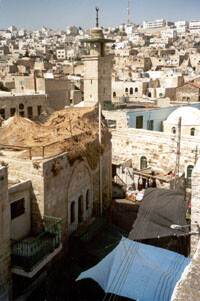
Hebron, occupation’s post (AEF, 2001)
Since October 2000, Israel has closed nearly all Palestinin towns and villages, placing large concrete blocks on nearly all exit roads, digging trenches across the roads and preventing commuters from passing through dozens of permanent and ad-hoc military checkpoints. The only roads which are regularly open are the Israeli-only-“bypass”-roads connecting Israeli settlements. Another purpose of the by-pass roads is to separate Palestinian towns and villages as they serve as a military grid, separating and surrounding Palestinian towns and villages with militarily-controlled roads.
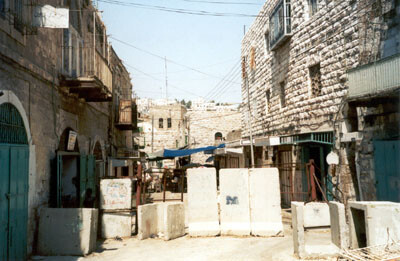
An Israeli army barricade in the center of Hebron (AEF, 2001)
Palestinian drivers usually try to circumvent the closures and blockades by using alternative minor roads or by risking travel on the bypass-roads, from which they are prohibited. Israeli soldiers have routinely beaten drivers, slashed their tires or shot at vehicles because they are using “closed” roads.
Human Rights Watch, the US-based human rights organisation, has documented more than a dozen cases of “serious abuses by Israeli security forces against taxi drivers and private drivers in the Hebron district alone” (See “Center of the Storm: A Case Study of Human Rights Abuses in the Hebron District”).
“My daughter is pregnant and cannot reach the hospital”, said the woman. “My husband cannot reach his work and I am the only one who can travel to Jerusalem and trying to sell what I have.” She travels every two days to Jerusalem, hoping to earn some money by selling fruit. However, because it takes double and sometimes tripple the regular travel times, also travel expenses have doubled. “It’s hard to make any living”, she said. Both the old woman and young man sighed. “Haram”, she said. “These road blocks and checkpoints”, she continued, “it’s haram, and God will punish them for that”.
H1, H2
Hebron is divided in the Oslo lexicon “H1” and “H2”. The status of the largest part of the city, “H1”, is similar to the one pertaining to “Area A”. Yet, the Israeli occupation forces maintain control over this part of the city, by occasionally establishing checkpoints at entrances to the city, or by closing these points of access. “H1” covers residential sectors as well as the commercial areas of Bab Al-Zawiya and Wadi Al-Tuffah, situated west of Hebron’s qasbah, the Old City.
In “H2”, the occupation has remained in full force, seriously affecting Palestinian daily life. “H2” covers approximately 20 percent of the municipal territory. It comprises the entire Qasba and areas adjacent to the Israeli settlements. The population in this area is composed of approximately 30,000 Palestinians and some 500 settlers. They have been placed under a nearly permanent, twenty-four hour curfew, requiring them to stay in their homes around the clock. The curfew is lifted for only a few hours every three days to allow them to do their groceries. This curfew applies only to the Palestinian residents of “H2”; Israeli hooligan settlers are allowed to walk and drive around freely at all times.
These collective punishments are one of the primary reasons for the increasing destitution and despair in the Occupied Territories and has made the lives of the population unbearable. As the service taxi reached the Bethlehem checkpoint, the old woman and the young man had to step out, walk towards and try to pass the checkpoint, hoping that at this time (18.00) there were still service taxis going to Hebron from Bethlehem, using all kinds of off-track routes, around villages and reaching Hebron after sunset.
